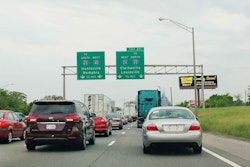
“On-duty time has seven definitions” in the federal regs, he noted, “and we can say for sure No. 5,” which concerns time attending the vehicle and/or conducting loading activities and which I referenced in the last post, “has remained the same. The ambiguity for the re-defintion of on-duty not-driving time might concern parts of No. 1, which talk about time at a plant, terminal, facility, or other property of a motor carrier or shipper, or on any public property, waiting to be dispatched, unless the driver has been relieved from duty by the motor carrier.”
As E.F. reads it, loading situations all told are off-limits for off-duty logged time. And: “It is my considered opinion [waiting-for-dispatch situations are] where some of the biggest abuses of a driver’s time take place.” An example: “A driver finishes his or her day at 10 p.m., goes into the sleeper berth at 11 p.m. and becomes available for dispatch at, let’s say, 10 a.m. But no dispatch is planned or given. The driver is up attending the vehicle. Then at 3 p.m. a dispatch is given to pick up a load at 7:30 p.m. and deliver at 8 a.m. the next morning 500 miles away from the shipper or pickup point. Are we now going to pretend this driver can or should be available to run such a load? I ask again, is this safe when you’ve been up all day? How many drivers have been coerced into this type of circumstance and have complied with these kinds of dispatches? This to me is beyond harrassment! It is nothing but abuse! Are we going to redefine on-duty time to practically punish drivers like this?”
Some law enforcement, as well, appear to be sticking with on-duty not-driving definitions as they traditionally have been viewed when it comes to loading situations.
“FMCSA can issue rules and guidance, but individual states and their DOT inspectors can also interpret that guidance any way that they want,” wrote Delmer Polak of Wisconsin-based Great Lakes Western, offering a recent example:
My driver arrived at a shipper in Idaho. He parked the vehicle, the load was not ready, and they said that he could leave until 3 p.m. He departed on foot and went to a local retail establishment for two hours, returning at the time the shipper had suggested. The next day he was inspected in Montana and received a failed logbook inspection for not recording that entire period as on-duty not-driving. I spoke with the inspector personally, and he had some interesting concepts. So after I presented several scenarios, he offered this: If the driver has a cellphone, and if he would be willing to answer that cellphone if either a dispatcher or shipper called him, then he was by definition on-duty not-driving. Not whether he had answered the phone, but whether he was willing to answer.
Unfortunately, as Polak notes, the carrier and driver’s only recourse in this situation is “a DataQ challenge, which is impossible to win…. We DataQ’d the violation to no avail.”
Seems a liberal interpretation of the new off-duty guidance is unlikely to fly in Montana, as Polak has it, “and very likely other jurisdictions.”
As for McHenry, he sees attempts to thwart real change for the better in leased and company driver treatment in any willingness to see off-duty ambiguity in the regs: “Can anyone actually think or believe a driver at a shipper or receiver can really be off-duty? Come on! What driver out there is really relieved of obligation? What driver at a shipper or receiver can really be able to be relieved and have no obligation so as to be able to go wherever on their own leisure or liberty, or be on leave, or pass, not be obligated in any way, ready to respond at a moment’s notice when loading or unloading is complete? How much more are we going to try to pretend a driver on a dock can actually be off-duty? If any of that is possible, why on earth do large carriers who are member carriers of the American Trucking Associations continue to pay hourly wage to their local truck drivers and consider all their hours as on-duty? …
“I see greed from all sides standing in the way of real change! Economist Peter Schiff once said something like this: One regulation leads to another regulation which leads to more regulations to correct prior ones, ad infinitum…’ … And it will never stop unless we decide today to draw that line in the sand and say enough is enough and stop!”
What do you think?
Perhaps acting like those hourly local drivers would pay dividends, ultimately, as Dave Nichols advised in this round-up of hours views, “Sit back, run easy, stop when it is convenient, not at the last minute, and behave like an hourly union driver would. In a few months, you will see the demand jump for trucks, but there will be none. The barriers to entry these days are just too high, and you will find yourselves in control.”











